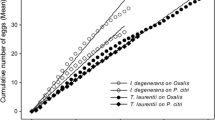Abstract
The biology of a strain of Neoseiulus idaeus Denmark & Muma from Carapó, State of Mato Grosso do Sul, was studied on two tetranychid prey, Mononychellus tanajoa (Bondar) and Tetranychus urticae Koch, at 25±1°C and 80±10% RH. The intrinsic rate of increase (rm) was considerably higher on T. urticae than on M. tanajoa (0.214 and 0.139, respectively). N. idaeus had lower total fecundity and net reproductive rate and higher mean generation time and sex ratio when the prey was M. tanajoa. Eggs of N. idaeus from Carapó were considerably more susceptible to low humidity levels than eggs of populations of N. idaeus originating from drier areas in northeastern Brazil.
Similar content being viewed by others
References
Araújo, W. F., Moraes, G.J. de and Delalibera Jr., I., 1991. Biologia do ácaro Amblyseius idaeus (Denmark & Muma) (Acari: Phytoseiidae). In: Resumos XIII Congresso Brasileiro de Entomologia, Recife, January 20–25, 1991, p. 1.
BakkerF.M., KleinM.E., MesaN.C. and BraunA.R., 1993. Saturation deficit tolerance spectra of phytophagous mites and their phytoseiid predators on cassava. Exp. Appl. Acarol., 16: 97–113.
BellottiA.C., MesaN.C., SerranoM., GuerreroJ.M. and HerreraC.J., 1987. Taxonomic inventory and survey activity for natural enemies of cassava green mites in the Americas. Insect Sci. Applic., 8(4/5/6): 845–849.
BirchL.C., 1948. The intrinsic rate of natural increase of an insect population. J. Anim. Ecol., 17: 15–26.
BraunA.R., MesaN.C., CuellarM.E., MeloE.L. and MoraesG.J.de, 1993. Biosystematics of phytoseiid mites (Acari: Phytsoeiidae) associated with cassava. Exp. Appl. Acarol., 17: 205–213.
CuellarM.E., 1992. Biosystemática de poblaciones de Amblyseius limonicus Garman and McGregor sensu lato y sensu stricto (Acarina: Phytoseiidae) y su importancia en el control del ácaro verde de la yuca. Undergraduate thesis. Universidad del Valle, Facultad de Ciencias. Departamento de Biologia. Cali, Colombia. 127 pp.
DinhN.V., SabelisM.W. and JanssenA., 1988a. Influence of humidity and water availability on the survival of Amblyseius idaeus and A. anonymus (Acarina: Phytoseiidae). Exp. Appl. Acarol., 4: 27–40.
DinhN.V., JanssenA. and SabelisM.W., 1988b. Reproductive success of Amblyseius idaeus and A. anonymus on a diet of two-spotted spider mites. Exp. Appl. Acarol., 4: 41–51.
Hargreaves, G.H., 1973. Monthly precipitation probabilities for northeastern Brazil. Department of Agricultural and Irrigation Engineering, Utah State University. Contract AID/csd 2167. 423 p.
McMurtryJ.A., 1992. Dynamics and potential impact of ‘generalist’ phytoseiids in agroecosystems and possibilities for establishment of exotic species. Exp. Appl. Acarol., 14: 371–382.
MesaN.C., BellottiA.C. and DuqueM.C., 1988. Ciclo de vida y tasa de incremento natural de Galendromus annectens, Neoseiulus idaeus y Phytoseiulus persimilis (Acari: Phytoseiidae). Revista Colombiana Entomologia, 14(2): 41–49.
Moraes, G.J. de, Alencar, J.A. de, Wenzel Neto, F. and Mergulhão, S.M.R., 1990. Explorations for natural enemies of the cassava green mite in Brazil. In: R.H. Howeler (Editor), Proc.Eighth Symposium of the International Society of Tropical Root Crops. Bangkok, Thailand, Oct. 30–Nov. 5, 1988, pp. 351–353.
NyiiraZ.M., 1972. Report of investigation of cassava mite, Mononychellus tanajoa Bondar. Unpublished Report, Kawanda Research Station, Kampala, Uganda, 14 pp.
SolomonM.E., 1951. The control of humidity with KOH, H2SO4, and other solutions. Bull. Entomol. Res., 42: 543–559.
YaninekJ.S. and HerrenH., 1988. Introduction and spread of the cassava green mite, Mononychellus tanajoa (Bondar) (Acari: Tetranychidae), an exotic pest in Africa and the search for appropriate control methods: a review. Bull. Entomol. Res., 78(1): 1–13.
YaninekJ.S., MégevandB., MoraesG.J.de, BakkerF., BraunA. and HerrenH., 1991. Establishment of the neotropical predator Amblyseius idaeus (Acari: Phytoseiidae) in Benin, West Africa. Biocontrol Science and Technology, 1: 323–330.
Author information
Authors and Affiliations
Rights and permissions
About this article
Cite this article
De Moraes, G.J., da Silva, C.A.D. & Moreira, A.N. Biology of a strain of Neoseiulus idaeus (Acari: Phytoseiidae) from Southwest Brazil. Exp Appl Acarol 18, 213–220 (1994). https://doi.org/10.1007/BF00114168
Accepted:
Issue Date:
DOI: https://doi.org/10.1007/BF00114168




